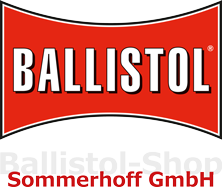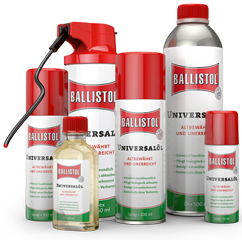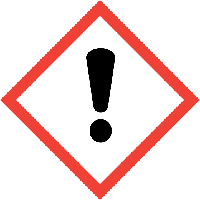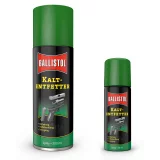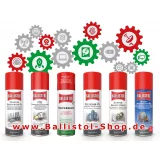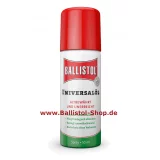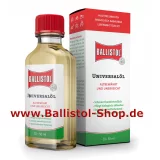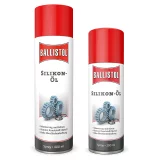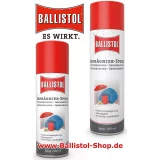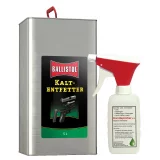Brake- and parts cleaner spray
- Manufacturer: Ballistol
- Product No.: 25340
- EAN: 4017777253405
- Content: 500 ml
- Datasheet: show
- Immediately ready for shipping
Delivery time 1 - 3 days inside Germany (further)- for deliveries abroad to the EU, Switzerland (CH) or Luxembourg (LU) within 3 - 5 days
- for all other foreign deliveries within 7 - 14 days
(Groundprice: 11,58 EUR per Liter)
Sliding-scale prices: from 5,36 EUR to 5,63 EUR
- 3 pcs
- per 5,63 EUR
- 6 pcs
- per 5,56 EUR
- 12 pcs
- per 5,48 EUR
- 18 pcs
- per 5,40 EUR
- 24 pcs
- per 5,36 EUR

Brake- and parts cleaner spray
The Ballistol brake- and parts cleaner is versatile. It is of course suitable for cleaning and degreasing dirty, oily or greasy machine parts, industrial parts, brakes and brake discs. The cleaner can also be used safely on clutch linings and brake blocks. In contrast to simple brake cleaner, it can also remove organic contaminants in addition to inorganic, i.e. technical oils and greases. This parts cleaner can even remove tree resin and stuck-on residue.
The parts cleaner ventilates without leaving any residue and has a pleasant scent and high material compatibility.
Ballistol's brake- and parts cleaner can also be easily used on paint and most types of plastic and rubber. An extra strong spray jet ensures that the cleaning effect is maximized, making the parts cleaner an ideal chain cleaner for coarse dirt.

Difference between brake- and parts cleaner and brake cleaner
The difference between brake cleaner and a parts cleaner can be found in the ingredients and how it works. The „simple“ cleaner works via an extremely fast evaporating solvent. The high pressure is also an element of the cleaning effect. That's why brake cleaner is only available as a spray. Such a cleaner is perfect for assembly work in a car workshop, for example.
A high-quality parts cleaner contains active cleaning ingredients. Orange terpenes and alcohol in the Ballistol parts cleaner provide enormous cleaning power with a pleasant scent. In addition, the parts cleaner has to work on a little more time before it evaporates. This means that stubborn dirt can be removed more thoroughly. Organic oils and fats and even dried tree resin are removed just as effortlessly as technical lubricants. This type of cleaner can also do everything a brake cleaner can do. That's why they're usually called brake- & parts cleaners. If you don't look closely, for example in a hardware store, this can lead to you buying something different than what you wanted.
Overview of the differences
| Brake- & parts cleaner | Brake cleaner | |
|---|---|---|
| Spray or liquid | spray, canister and large containers | Only as a spray |
| Ingredients | Active cleaning substances, here orange terpenes and alcohol. Only with spray also carrier and propellant. | Solvent, carrier substance, propellant |
| Dissolves organic fats and oils | yes | to a certain extent, perhaps cleaning several times and helping manually |
| Dissolves technical lubricants and assembly pastes | yes | yes |
| Dissolves stuck deposits | yes | no |
| Ventilation time | fast | extremely fast |
| Dissolves tree resin | yes | no |
| Suitable for rubber and plastic | yes, in most cases | no |
Overview of all Ballistol brake cleaners
- 500 ml or 4 x 500 ml pack brake cleaner spray
- 500 ml brake- and parts cleaner
- 5 liter canister of brake- and parts cleaner
- 200 liter barrel of brake- and parts cleaner
 Parts Cleaner makes dirty brushes like new
Parts Cleaner makes dirty brushes like new
After heavy soiling all brushes such as our bristle brushes, wire brushes and wool wiper can be cleaned again perfectly with the parts cleaner for renewed use.
Technical characteristics
- Appearance: colourless, clear
- Smell: fruity
- Flash Point: Spray approx.12 °C / Liquid approx. -4 °C (with solvent)
- Boiling Range: Spray 80 °C / Liquid not determined
- Ignition Temperature: Spray approx. 425 °C (with solvent)/ Liquid not determined
- Vapour Pressure: Spray approx. 59 hPa (at 20 °C, with solvent)/ Liquid not determined
- Rel. Density Spray: approx. 0.74 g/cm³ (at 20 °C)
- Rel. Density Liquid: approx. 0.74 g/cm³ (at 20 °C & with pycnometer)
- Lower / Upper Explosion Limit: Spray approx. 3.5 Vol-% / approx.15 Vol-% (for solvent)/ Liquid not determined
Details zur Produktsicherheit
Verantwortlicher Wirtschaftsakteur gemäß EU-Verordnung:F.W. Klever GmbH
Hauptstraße 20
84168
Deutschland
info@ballistol.de
Kennzeichnung gemäß Verordnung (EG) Nr. 1272/2008 [CLP/GHS]
- Signalwort: Gefahr
- Gefahrenhinweise für Gesundheitsgefahren
- H222 Extrem entzündbares Aerosol.
- H229 Behälter steht unter Druck: Kann bei Erwärmung bersten.
- H315 Verursacht Hautreizungen.
- H319 Verursacht schwere Augenreizung.
- H336 Kann Schläfrigkeit und Benommenheit verursachen.
- H411 Giftig für Wasserorganismen, mit langfristiger Wirkung.
- Sicherheitshinweise
- Allgemeines
- P101 Ist Ärztlicher Rat erforderlich, Verpackung oder Kennzeichnungsetikett bereithalten.
- P102 Darf nicht in die Hände von Kindern gelangen.
- Prävention
- P210 Von Hitze, heißen Oberflächen, Funken, offenen Flammen sowie anderen Zündquellenarten fernhalten. Nicht rauchen.
- P211 Nicht gegen offene Flamme oder andere Zündquelle sprühen
- P251 Nicht durchstechen oder verbrennen, auch nicht nach Gebrauch.
- P264 + P265 Nach Gebrauch Hände gründlich waschen. Augen nicht berühren.
- P271 Nur im Freien oder in gut belüfteten Räumen verwenden.
- P280 Schutzhandschuhe / Schutzkleidung / Augenschutz / Gesichtsschutz tragen.
- Reaktion
- P305 + P351 + P338 BEI KONTAKT MIT DEN AUGEN: Einige Minuten lang behutsam mit Wasser spülen. Eventuell vorhandene Kontaktlinsen nach Möglichkeit entfernen. Weiter spülen.
- P332 + P313 Bei Hautreizung: Ärztlichen Rat einholen / Ärztliche Hilfe hinzuziehen.
- P337 + P313 Bei anhaltender Augenreizung: Ärztlichen Rat einholen / Ärztliche Hilfe hinzuziehen.
- P362 + P364 Kontaminierte Kleidung ausziehen und vor erneutem Tragen waschen.
- Lagerung
- P405 Unter Verschluss aufbewahren.
- P410 + P412 Vor Sonnenbestrahlung schützen. Nicht Temperaturen über 50 °C/122 °F aussetzen
- Entsorgung
- P501 Inhalt / Behälter der Entsorgung gemäß den örtlichen / nationalen / internationalen Vorschriften zuführen.
